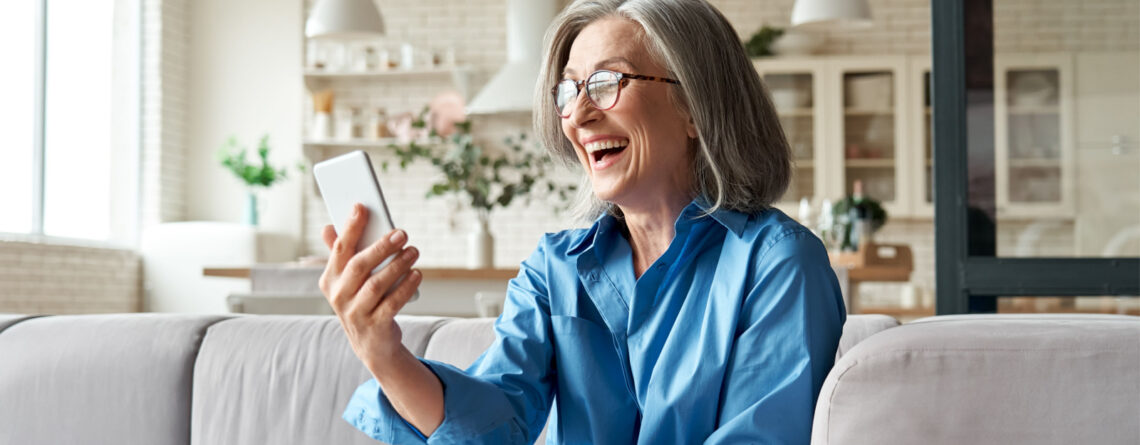How caregivers are using smart tech to help aging parents
As my mother reached her 90s, although she was relatively healthy and active, I realized that she was starting to experience some physical limitations and memory issues. And while I didn’t live far away, I knew that I needed to find a way to help her live on her own comfortably and safely despite her increased dependence. More traditional technologies, such as wearable alert systems, could only do so much (especially when she refused to wear them). So I started looking at smart home tech — and started finding some better answers.
I’m not alone. According to the US census, in 2020, the number of people in the United States aged 65 or older reached 55.8 million, or 16.8 percent of the population, and many are choosing to “age in place.” And an increasing number of their children, relatives, and friends — in other words, their caregivers — are looking to smart technology to help.
To get a sampling of how caregivers are using today’s smart technology, I interviewed some members of a support group called Working Daughter; I also spoke to a colleague here at The Verge. What follows are some ways that caregivers are using current smart technology to help their aging or ailing parents live more comfortably at home — and to allow the caregivers themselves to worry less and hopefully have more time for themselves.
Smart assistants
Amazon may have reduced the number of people working at its Alexa division, but as far as many of the people I contacted are concerned, an Alexa device is one of the most useful tools for helping caregivers monitor and help their loved ones. (Interestingly, of the several people who wrote to me, only one used Google Home; all the others had Echo Shows or Dots.)
When I became aware that my mother was starting to have memory issues, I got her an Echo Show 8, hoping that it would help with reminders, perhaps let her feel less isolated — and let me be able to remotely handle any difficulties that came up. And (at least for a while) it worked. Alexa would remind her to take her meds every day, and if she was feeling sad, she could say, “Alexa, play some nice music,” and it would invariably come up with something she enjoyed. And she knew that if she was in an emergency situation and was not near a phone, she could call out, “Alexa, call Barbara,” and it would ring my phone.
Sheena Vasani, commerce writer for The Verge, also uses Alexa as a tool for her mother, who has Parkinson’s disease — and who is, Sheena admits, pretty tech adverse. But despite that, the Echo Show has become useful for both Sheena and her mother with a variety of things: to remind them both when medications need to be taken, for example, and so that Sheena can “drop in” on her mom’s room during the workday to make sure everything is okay. Alexa also helps with the isolation that illness can bring. “My mom talks to her like she’s a pet,” Sheena says. “It gives us that companionship.”
Working Daughter member Linda Alpers lives with her parents and says that she has an Alexa in every room of the house. That way, she says, “I can drop in if they don’t answer the phone when I’m out. I also have Blink cameras trained on their chairs in the living room and kitchen in case the TV volume is too loud for them to hear me if I use drop in on Alexa. I also use Alexa to allow them to control lights, TV, and a few things plugged into smart plugs. As my dad’s Parkinson’s took his voice, we got him an iPad and added a customizable speech app called TD Snap and added the Alexa phrases so he could continue to use all of Alexa’s functions he was used to.”
On the whole, she says, “I don’t know how I would have survived this long without the smart technology.”
“I don’t know how I would have survived this long without the smart technology.”
However, some caregivers have found Alexa wanting. Paula Fontes-Paul got her father an Echo for his 94th birthday, set it up for him, and decided to start with something simple: having him request his favorite music. “Despite the fact he is USA born and raised, Spanish is his first language,” she explains, “and he’s always had an accent — one that Alexa had a hard time understanding. Between Alexa not understanding him, and [the fact] that he wore two hearing aids and was still nearly deaf so he didn’t understand her, and his reluctance to have anything to do with modern technology — it was a dismal failure.”
Smart cameras
Sometimes a smart speaker isn’t enough — especially when cognitive decline is involved and something as seemingly easy as remembering to ask an Echo Show to “call my daughter” might be too difficult.
Many caregivers are handling that problem with cameras, which allow them to monitor their parents and watch out for falls and other emergencies. Sarah VonHarten’s mother, who is suffering from dementia, lives alone and has aides during the day. Like many people with dementia, she sometimes has trouble expressing herself or explaining what has really happened when there is a problem. VonHarten uses a Wyze smart camera with two-way audio and is pleased that she can now rewatch any falls or other incidents her mother reports to better understand what happened. In addition, as her mother loses the ability to use a phone, “When I talk using the camera she loves to stand there and talk to me. I can also talk to the EMS if they have to come help her.”
Similarly, Anica Leon-Weil, who is raising a young child and lives about 25 minutes away from her mother, used cameras to deal with her mother’s advancing Alzheimer’s disease. “I set up a camera system so that I could have a visual way to monitor what was going on. And that made a huge difference right off the bat because often she would call about something but she didn’t have the language to describe what was actually happening. Once I put in cameras, I could actually see what was happening.” Like VonHarten, Leon-Weil also used the two-way camera system to communicate with her mother when the latter lost the ability to use a phone.
However, sometimes the tech failed because of weather conditions. Leon-Weil lives in an area where there are frequent storms. “If the internet was out, the cameras were out, and then I could not do any of the things that I needed to do.”
Pill dispensers
According to Liz O’Donnell, the founder of Working Daughter, pill dispensers such as those produced by a company called Hero Health can be incredibly useful. They alert people when it’s time to take pills and dispense the correct pill(s) in the correct dose.
VonHarten uses a medicine dispenser that she calls “a life changer. I [load it with] two weeks of medication and the machine is locked and turns at a set time twice a day, and alarms until it is turned over to release that dose of medication.” She says that, as a result of using the dispenser, her mother’s health improved. Leon-Weil also found that a smart pill dispenser was useful for a time, until her mother was no longer able to manage her own medications.
Trackers
Along with a camera system and a smart pill dispenser, Leon-Weil has used Samsung SmartTags for important items that her mother kept losing — and also to track her mother in case she wandered, which can be a problem for people with Alzheimer’s disease. “It was an imperfect system,” she admits. “My mom lives somewhere where it’s not heavily populated. And the way the tags work is like they hang off of other people’s phones, so sometimes it would be very accurate and sometimes it was less so” depending on how many people with Samsung phones were in the vicinity. (AirTags and Tile trackers are other options.)
Smart companions
Loneliness can be a problem for older people, especially if they are confined to their homes. Besides smart assistants such as Alexa, there are devices that are specifically meant to act as companions. There are also “pets” created by companies like Joy For All, which, according to O’Donnell, can move and purr. “There’s working daughters I know that are buying those for their family members who have dementia and who are really happy with the results,” she says.
A complete smart home
A caregiver who is really determined and who has the know-how can create a quite sophisticated smart home setup.
The Verge’s Sheena Vasani has started to expand her use of smart technology in her household, adding smart plugs to make it easier to turn lights on and off using Alexa, for example, and a smart thermostat that she or her mother can adjust from the phone. And next? “I’m looking at trying to get her into robot vacuums,” Vasani admits. “Just because I never really have time to vacuum.”
Jena Reed is an IT professional who has been living with her mother, who is disabled and in remission from cancer, for about 14 years. When they moved from a three-story townhouse to a single-level home, “I decided it was just going to be a lot easier if we could automate and voice-activate as much as we possibly could.”
“I decided it was just going to be a lot easier if we could automate and voice-activate as much as we possibly could.”
She got an Amazon Echo device for every room in the house so that her mother could “drop in” to any room if she needed to. “There have been a couple of times where she has fallen,” explains Reed. “Usually it’s because she’s overextended herself, or tried to lean over too far, whatever it may be. So having that capability to allow her just to say [Alexa], drop in on me? I’ve been able to [go and help her] and at least get her situated until the paramedics showed up to lift her.”
Reed also replaced all her light fixtures with smart switches — but then changed her mind. “I found that they only work well for about two or three years,” she explained. As a result, she replaced all her switches with standard ones and installed smart bulbs. “I can set up functions and routines with Alexa and still have the same features.”
“We named all of our lamps [so we can say] ‘Turn on Mom’s light,’ ‘Turn on guest room,’ that kind of thing. And that has worked really well. She can tell the Amazon assistant to set the temperature and she can tell it to turn fans on and off.” Reed also set up smart blinds with a bridge adapter so her mother can tell Alexa to raise or lower the blinds in individual rooms.
And there’s more: Reed has set up Ring outdoor cameras so that her mother both feels secure and can enjoy a view of the outdoors, even at night. And while Reed hasn’t seen the need to set up many inside cameras to help her mother — she feels the cameras on the Amazon Echo Shows are sufficient — she has set up some cameras from Nooie for a different reason. “I volunteer for a local pet rescue, so I have a foster room, and then I have my own animals. I’ve actually set [the cameras] up in various rooms, so she can ‘come in’ and check them out and see what’s going on in the foster room without having to physically go in there.”
Aging in place in the smart home
Today’s smart technology certainly isn’t perfect, and not all caregivers have the knowledge or resources to set up a truly automated smart home. And some older individuals are resistant to technology, which can make things even more difficult for caregivers. However, there are often (but not always) ways around that. For example, Leon-Weil found her mother was willing to work with the devices once she understood what they were for. “I’m fortunate my mom was quite easygoing,” says Leon-Weil. “When I explained it the way that I explained it, which was like, I want to be able to help you better. This will help me to help you.”
But despite the hurdles that caregivers face, many find that even one or two smart displays or a few cameras can make a real difference in their lives — and in the lives of those who are aging and trying to retain their independence.
Read more @theverge











